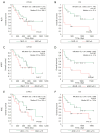Comparing neutrophil-to-lymphocyte ratio (NLR), absolute neutrophil count (ANC) and derived NLR as predictive biomarkers in first-line immunotherapy for non-small cell lung cancer: a retrospective study
- PMID: 40386737
- PMCID: PMC12082228
- DOI: 10.21037/tlcr-24-808
Comparing neutrophil-to-lymphocyte ratio (NLR), absolute neutrophil count (ANC) and derived NLR as predictive biomarkers in first-line immunotherapy for non-small cell lung cancer: a retrospective study
Abstract
Background: Lung cancer, especially non-small cell lung cancer (NSCLC), poses a significant global health challenge due to its high prevalence and poor prognosis despite treatment advancements, including immunotherapy. While programmed death-ligand 1 (PD-L1) expression is a commonly used biomarker, its limitations justify exploration of alternative markers like the neutrophil-to-lymphocyte ratio (NLR), absolute neutrophil count (ANC) and derived NLR (dNLR). This retrospective study aims to directly compare NLR, ANC and dNLR as predictive biomarkers in first-line NSCLC immunotherapy, shedding light on their prognostic implications and potential clinical utility.
Methods: This retrospective single-center study included 70 consecutive patients diagnosed with metastatic NSCLC, treated in first-line with immune checkpoint inhibitors (ICIs) between September 2015 and March 2023 at the University Hospital of Reims, France. Baseline clinical characteristics and hematological values were collected, and survival analysis, including progression-free survival (PFS) and overall survival (OS), was performed based on RECIST (Response Evaluation Criteria in Solid Tumors) criteria. NLR and dNLR were calculated, and their predictive performances were assessed.
Results: Baseline characteristics revealed a median age of 65.5 years, predominantly adenocarcinoma histology (82.9%), and high PD-L1 expression (≥50%) in 61.4% of cases. Neither NLR, ANC nor dNLR showed significant associations with known clinical outcome influencers like age, PD-L1 expression, or performance status, but dNLR correlated significantly with initial response (P=0.02). While NLR ≥5 was significantly associated with shorter PFS and OS (P=0.03 and P<0.001, respectively), dNLR >2.5 (P=0.008) or ANC >7.5 (P=0.02) showed significance in predicting poorer OS only. Optimal cut-off values were determined as 5.0 for NLR [area under the curve (AUC) =0.570], 9.00 for ANC (AUC =0.683) and 2.496 for dNLR (AUC =0.610) for OS prediction. Cox regressions revealed no significant association between either biomarker and clinical or histological cofactors. Subgroup analyses suggested NLR's predictive consistency across various subgroups, whereas dNLR and ANC showed limited performance. Both biomarkers demonstrated significant association with OS in patients exposed to ICI alone, but not with chemotherapy combination.
Conclusions: The results underscore the potential of NLR as a predictor of survival and progression in NSCLC patients treated with immunotherapy, while dNLR and ANC demonstrate more limited interest. However, larger prospective studies are needed to confirm these observations and further elucidate their clinical utility.
Keywords: Non-small cell lung cancer (NSCLC); biomarker; derived neutrophil-to-lymphocyte ratio (dNLR); immunotherapy; neutrophil-to-lymphocyte ratio (NLR).
Copyright © 2025 AME Publishing Company. All rights reserved.
Conflict of interest statement
Conflicts of Interest: All authors have completed the ICMJE uniform disclosure form (available at https://tlcr.amegroups.com/article/view/10.21037/tlcr-24-808/coif). G.D. reports payment or honoraria for lectures, presentations, speakers bureaus, manuscript writing or educational events from AstraZeneca, Chiesi, Sanofi, GSK (personal fees), outside of the submitted work. J.A. reports grants from AMGEN, French Innovative Research Fund; payment or honoraria for lectures, presentations, speakers’ bureaus, manuscript writing or educational events from Roche, Pfizer, MSD, Bristol-Myers Squibb, Novartis, AstraZeneca, Takeda, Sanofi, and Amgen; support for attending meetings and/or travel from Roche, Pfizer, MSD, Takeda, and Sanofi. The other authors have no conflicts of interest to declare.
Figures





References
LinkOut - more resources
Full Text Sources
Research Materials
